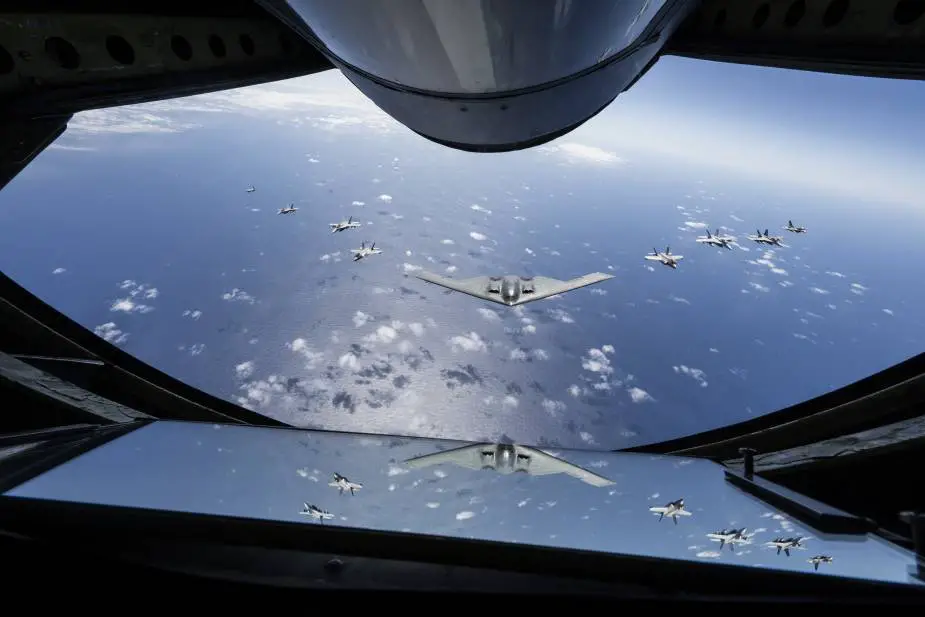Breaking news
B-2 Spirit conducts mission in Indo-Pacific for training with Royal Australian Air Force.
A U.S. Air Force B-2 Spirit flew from the 509th Bomb Wing, Whiteman Air Force Base, Missouri, to Royal Australian Air Force Base Amberley, Australia, March 23, 2022, to execute training with the Royal Australian Air Force to increase interoperability with a critical ally and operate forward in the Indo-Pacific region. Tech. Sgt. Hailey Haux Pacific Air Forces Public Affairs, reports.
Follow Air Recognition on Google News at this link
 A U.S. Air force B-2 Spirit from Whiteman AFB flies in formation with two Australian Air Force F-35A Lightning IIs, two RAAF F/A-18F Super Hornets, two RAAF EA-18 Growlers, and two USAF F-16C Aggressors from Eielson AFB during a training mission in the Indo-Pacific Mission, March 23, 2022. (Picture source: Tech. Sgt. Hailey Haux)
A U.S. Air force B-2 Spirit from Whiteman AFB flies in formation with two Australian Air Force F-35A Lightning IIs, two RAAF F/A-18F Super Hornets, two RAAF EA-18 Growlers, and two USAF F-16C Aggressors from Eielson AFB during a training mission in the Indo-Pacific Mission, March 23, 2022. (Picture source: Tech. Sgt. Hailey Haux)
Once in Australian airspace, the B-2 teamed up with a KC-135 Stratotanker from the Alaska Air National Guard to complete aerial refueling before integrating with eight fighter aircraft—two Royal Australian Air Force F-35A Lightning IIs, two RAAF EA-18 Growlers, two RAAF F/A-18F Super Hornets and two U.S. Air Force F-16C Aggressors —to conduct training operations.
The B-2 then landed at Amberley—for the first time—and conducted a crew swap before becoming airborne, integrating with F-22 Raptors from Joint Base Pearl Harbor-Hickam, Hawaii, and returning back to Whiteman.
U.S. Navy Adm. John C. Aquilino, commander of U.S. Indo-Pacific Command, and Royal Australian Air Force Air Vice-Marshal Joe Iervasi, Air Commander Australia, observed the B-2 aircraft on the ground at Amberley and met with the air and ground crews: “This is the most consequential theater with the most challenging security issues…and advancing our interoperability with critical allies like Australia is critical to maintaining a free and open Indo-Pacific,” Aquilino said. “There are many aspects that are going on daily to continue to move the security relationship forward in a positive way to provide deterrence, prevent war, and maintain peace and stability within the region.”
Air Vice-Marshal Iervasi echoed the importance of the training and increased interoperability: “This is the most important relationship that we have in the Indo-Pacific region,” Iervasi said. “We have enduring bonds extending back for decades and we share common values and interests and we will continue to collaborate and keep this partnership strong.”
U.S. Air Force Lt. Col. Christopher Conant, 393rd Bomb Squadron commander, led the U.S. effort on the ground and said it was missions like these that are how we exercise our global strike capabilities: “It’s our job to get out and support our Combatant Commanders and we’re always excited to be in the Indo-Pacific,” Conant said. “The main pillar of the National Defense Strategy is building relationships with our allies and partners because warfighting is a team sport, and our network of alliances and partnerships remains the backbone of global security.”
While the B-2 crews were teaming up with RAAF counterparts and U.S. teammates in the air, other U.S. Airmen were conducting joint operations on the ground working side-by-side with different RAAF members such as security forces, fuels, maintenance, and firefighters.


























